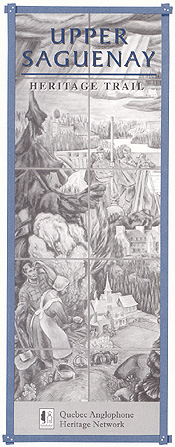
Lore in the Saguenay runs deep. From fabled kingdom to royal monopoly to realm of industry, four centuries of Quebec history unfold along its shores. Though never large in number, English Quebecers helped shape a big part of that history.
The Saguenay flows 160 kilometres through a rift in the Canadian Shield from Lac St-Jean to Tadoussac on the St. Lawrence River. The juncture of these mighty streams was a traditional bartering point for Iroquois and Algonquin peoples. Trading posts along the river were vital to New France. By 1671, the Saguenay route linked Indigenous trappers as far as James Bay with fur buyers in Europe. When France ceded Canada to Britain in 1763, control of the King’s Posts fell to English merchants. The famous North West Company of Montreal and later the powerful Hudson’s Bay Company would rule the region for a century.
An English-born entrepreneur from Quebec City named William Price is regarded as the father of the Saguenay. The thriving wood trade he founded broke the monopoly of the fur economy, giving rise to a way of life based on farming, forestry, hydro-electric power and metallurgy.
GETTING THERE
This Heritage Trail leads to historic settlements and points of interest in the upper Saguenay, starting at La Baie. Together these communities are called Ville Saguenay, today. The quickest way from Quebec City is north through Laurentide Park on Route 175. From Montreal, head for Trois-Rivières, then drive north toward Lac St-Jean on Route 155.
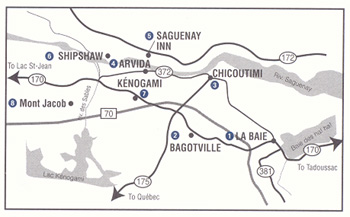 LA BAIE (Port Alfred) (pop. 21,000)
LA BAIE (Port Alfred) (pop. 21,000)
This lively port town offers visitors magnificent waterfront views on historic Ha Ha Bay. The bay and a nearby river take their name from a Montagnais Indigenous term meaning little path in the woods. Known as Grande Baie to fur-traders and pioneers, the community was founded in 1838 by la Société des Vingt-et-Un, a group of French Canadians from the St. Lawrence valley who built sawmills on the Saguenay’s tributaries.
In 1842 William Price bought the mills and cutting rights in the region. Many early settlers worked for Price during winter months and farmed during the summer. The Saguenay’s industrial age had begun.
The little Protestant cemetery on rue Alexis Tremblay bears the names of early English residents. A museum on Blvd. Grande Baie Ouest tells about the early history of the bay.
Price Bros. Company built the town’s prominent Port Alfred newsprint mill in the 1920s. Today, forest giant Abitibi Consolidated employs 600 workers.
Saguenay paper, forest products and aluminum are all shipped to market through the port, which is operated by Alcan. Shipments of bauxite, the mineral used to make aluminum, come into La Baie from Jamaica, South America and Africa.
Musée du Fjord - (418) 697-5077
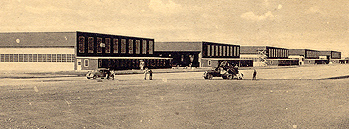 BAGOTVILLE AIR BASE
BAGOTVILLE AIR BASE
Visitors interested in Canada’s military and aviation heritage should plan to visit CFB Bagotville, located between La Baie and Chicoutimi. From mid-June to late August, air force personnel offer twice-daily guided bus tours seven days a week. The base was built in 1942 to train RCAF pilots and to protect the Saguenay’s strategic aluminum and hydroelectric facilities during World War II. Bagotville’s Air Defence Museum tells about this history and about technological developments in aeronautics.
Now continue west on Rte 170 and take the exit for Blvd. Saint Paul into Chicoutimi.
Bagotville Air Defence Museum
(418) 677-4000 Ext. 8159
CHICOUTIMI (pop. 64,000)
The economic and cultural centre of the Saguenay, Chicoutimi blends urban sophistication and gorgeous natural scenery. Founded as a trading post in 1676, the city marks the upstream limit of river navigation. Its name is a Montagnais term meaning, this far the water is deep.
Chicoutimi sprang up in the 1840s as a lumber town. Peter McLeod, the son of a Hudson’s Bay Co. agent from Scotland and a Montagnais mother, built the first sawmills on the Chicoutimi and Moulin rivers. McLeod was an early partner of William Price, who later bought the mills along with vast timber holdings. A monument to the Price family, erected in 1882, stands east of the Old Port district.
The opening of a pulp mill on the Chicoutimi River in 1897 set the stage for rapid growth in the early 20th century. The mill was the brainchild of Sherbrooke native Julien-Edouard-Alfred Dubuc, whose Compagnie de pulpe de Chicoutimi employed upwards of 1,000 workers in 1920. La Pulperie, a museum and cultural centre housed in Dubuc’s remarkable neo-classical stone mill downtown, gives details about this heritage.
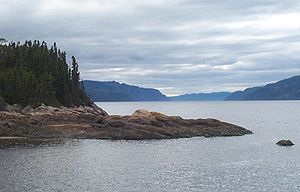 Homes along nearby Drean and Ross streets in the historic Le Bassin district formed an English enclave where regional head-office staff lived during peak years of the Price company’s Saguenay operations. In July 1996 torrential rains triggered flash flooding on the Chicoutimi River, destroying many houses below the dam. A lone white house left clinging to the hillside next to l’Église Sacré-Coeur, Chicoutimi’s historic gothic-style granite church, recalls the devastation.
Homes along nearby Drean and Ross streets in the historic Le Bassin district formed an English enclave where regional head-office staff lived during peak years of the Price company’s Saguenay operations. In July 1996 torrential rains triggered flash flooding on the Chicoutimi River, destroying many houses below the dam. A lone white house left clinging to the hillside next to l’Église Sacré-Coeur, Chicoutimi’s historic gothic-style granite church, recalls the devastation.
Follow signs for Blvd. du Saguenay and drive west along the river shore.
La Pulperie
300 rue Dubuc - (418) 698-3100
Website: www.pulperie.com
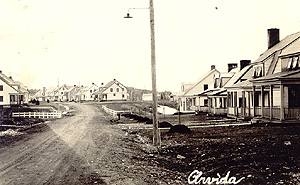 ARVIDA (Ville de Jonquière)
ARVIDA (Ville de Jonquière)
In the 1920s, Alcan’s famed aluminum plant and the town beside it brought a new wave of English-speaking families to the Saguenay.
Arvida sits on land first cleared around 1840 by Simon Ross, a fur trader and one of the few English homesteaders ever to settle in Jonquière Township. In 1925 American tobacco millionaire J.B. Duke and William Price III dammed Lac St-Jean, raising the water level five metres to feed their powerhouse at Isle Maligne. A year later the region’s first aluminum smelter went into production.
Arvida was wholly planned by the U.S. company that built it. In 1926, Alcan’s predecessor, the Aluminum Company of America (Alcoa) built 270 worker’s houses in 125 days. Within a few years the town had schools, a hospital, three banks and two churches, including the stately brick Ste. Thérèse Catholic Church (1928). The town’s name was derived from the name of Alcoa president Arthur Vining Davis, also Alcan’s founder.
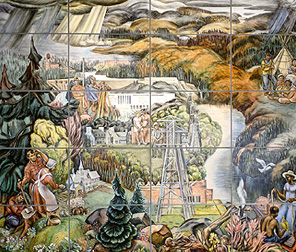 A vibrant English-speaking community once thrived in Arvida because many skilled employees were recruited from the U.S. and other parts of Canada. During the 1930s, 40s and 50s, large numbers of Europeans also moved here to rebuild lives shattered by war. In the 1960s, Arvida merged with the City of Jonquière.
A vibrant English-speaking community once thrived in Arvida because many skilled employees were recruited from the U.S. and other parts of Canada. During the 1930s, 40s and 50s, large numbers of Europeans also moved here to rebuild lives shattered by war. In the 1960s, Arvida merged with the City of Jonquière.
Today, Arvida First United Church (1949) on Berthier St. serves a French baptist congregation while St. George’s Anglican (circa 1950) nearby holds French evangelical services. Riverside Regional High School on Joule St. and Riverside Regional Elementary on Neilson St. continue to offer English classes to roughly 500 students.
SAGUENAY INN (Manoir du Saguenay)
Built in 1940 to lodge Alcan guests and out-of-town staff, the Saguenay Inn is a well-known landmark featuring French-Château style architecture. It’s located on Powell St. near the Riverside schools. In the 1950s the Inn was opened to the public, and for many years Arvida residents gathered here for receptions, parties and graduation ceremonies. Alcan now uses the building exclusively for corporate functions. However, visitors may park in front and admire the grounds, designed by Tom Heard, an associate of famous landscape artist Frederic Law Olmsted. There is a scenic walking trail that leads to the river.
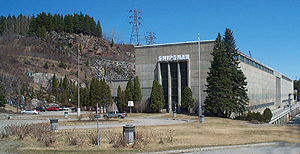 SHIPSHAW POWERHOUSE
SHIPSHAW POWERHOUSE
Aluminum demand surged during World War II as Allied nations rushed to build up fleets of combat planes. It took 9,000 workers recruited from all over eastern Canada to build this magnificent 64-metre-high dam on the Saguenay River. Capable of generating 896,000 kilowatts of electricity, the powerhouse helped Alcan expand its aluminum output significantly during the war. A marvel of engineering, Shipshaw ushered in a new era of large hydropower development in Quebec that would make the province a North American leader in electricity production.
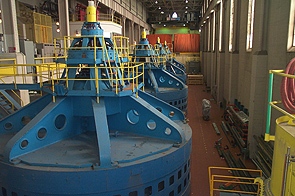 KENOGAMI (Ville de Jonquière)
KENOGAMI (Ville de Jonquière)
A company town started by the Price Bros. company in 1910, Kenogami was the site of the first paper mill in the Saguenay-Lac St-Jean region. Today Abitibi Consolidiated operates the mill site on the east bank of Rivière-aux-Sables; Cascades owns a cardboard mill on the west bank.
In the early days, Price Bros. relied on local French-Canadian labour and skilled paper-makers recruited mainly from Great Britain. Vestiges of this era can be seen in the old English quarter at Parc Alonzo Gravel, off rue du Roi-Georges. Mill bosses lived in the fine brick homes fronting the park. Every summer families use to gather in the park for a company-sponsored picnic known as Field Day.
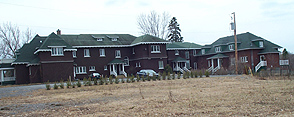 At the height of their pulp-and-paper dynasty, the Price family kept a beautiful summer residence on rue Perron. The red cedar-shingled house is now an apartment complex. Beside it, note the elegant Tudor-style Auberge Villa Pachon. This too was Price company property, a mill-manager’s residence that later served as lodging for out-of-town guests. The inn operates independently today.
At the height of their pulp-and-paper dynasty, the Price family kept a beautiful summer residence on rue Perron. The red cedar-shingled house is now an apartment complex. Beside it, note the elegant Tudor-style Auberge Villa Pachon. This too was Price company property, a mill-manager’s residence that later served as lodging for out-of-town guests. The inn operates independently today.
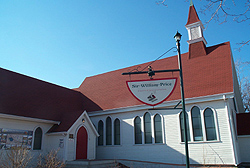 In the 1950s, Kenogami’s English-speaking community supported a school and two Protestant churches, including St. James the Apostle Anglican (1912), the first Protestant church built in the upper Saguenay. Today St. Jame’s houses the Sir William Price History Centre, a museum devoted to the Saguenay’s industrial heritage.
In the 1950s, Kenogami’s English-speaking community supported a school and two Protestant churches, including St. James the Apostle Anglican (1912), the first Protestant church built in the upper Saguenay. Today St. Jame’s houses the Sir William Price History Centre, a museum devoted to the Saguenay’s industrial heritage.
Centre d’Histoire Sir-William-Price
1994, rue Price - (418) 695-7278
MONT JACOB (Ville de Jonquière)
Round off your tour with a visit to the top of Mont Jacob, site of the renowned Centre National d’Exposition (CNE). Overlooking Jonquière, Kenogami and Arvida, the CNE offers panoramic views of the upper Saguenay Valley and the Valin Mountains. The museum features works by Québécois, Canadian and international artists.
Centre National d’Exposition
4160, rue du Vieux Pont - (418) 546-2177
The Heritage Trail series is presented by the Quebec Anglophone Heritage Network, funded jointly by the Department of Canadian Heritage and Economic Development Canada. Space constraints preclude mention of all possible sites. Thanks to René Mimeault, Paul Delisle, Margaret MacDougall and Caroll Ann Doucet. For more information, call the QAHN office at (819) 564-9595 or toll-free within Quebec at 1 (877) 964-0409.![]()
![]()